Ideological context:
Before proceeding with the analysis, it is necessary to discuss two broad and global concepts that will provide the conceptual framework for all this writing. The first refers to the symbolic duality and the second to the tripartite notion of the Moche religion regarding Life, Death and the Ancestors. These three terms, often referred to as the "World of the Living", the "World of the Dead" and the "World of the Ancestors", have been used, almost interchangeably, to describe certain scenes of iconography. I will start with the concept of duality and then proceed to the idea of the tripartite system.
A dual system: The symbolic duality impregnated all of the Moche religion and has been detected in ritual acts – funerary and sacrificial – both in the Huaca de la Luna. In tombs, there are pairs of identical vessels and, in the case of sacrificial sites, there are pairs of human bodies (Bourget 2001b:114). Among the ceramic offerings from this funerary context was also an intriguing portrait vessel showing the head of a man with an excised nose and lips. This form of mutilation was common and numerous individuals appear in this way in the iconography. They are usually shown riding a llama or sitting in front of a building and, less frequently, in sexual acts. Facial mutilation transformed the face of a living being into a skull, a kind of true living-dead. The interaction between life and death is often represented with the ambiguity between monkey and skeletonized character or skull. For example, the front view of Figure 2 appears to represent a skeletonized character holding a pan flute. However, on closer inspection, the sculpture shows a very peculiar shoulder joint and the tail of a monkey. Thus, a double duality occurs between life and death and between a human being and a monkey. In another portrait vessel, the double game between the human and the animal and between life and death is expressed in the face, showing human, monkey and skeletal features at the same time. A similar kind of tension resulting from the transition between these two states may have been created with another portrait-vessel showing a one-eyed man. In this case, vision in one eye and blindness in the other would also express the dualistic concept of life and death, as occurs in the representations of individuals covering one eye with one hand. Each of these “transient types” – mutilated face, skeletonized face and one-eyed man – play a role in the sexual theme:the undead, the skeletonized monkey-character and the one-eyed man. In itself, this theme may have been closely related to some kind of transition or phase of the life cycle. As a hypothesis, it can be suggested that in Moche iconography there is a transitory stage between life and death that seems to have been expressed through a number of symbolic elements -dual beings or transitory beings- such as the living-dead, man- monkey and the one-eyed man
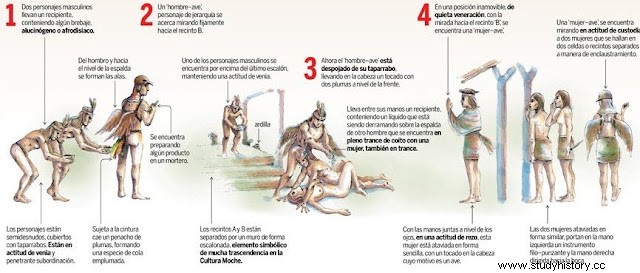
The existence of a tripartite system in Moche iconography and religion, constituted by a World of the Living, a World of the Dead and a mythical World of the Ancestors –the latter populated by supernatural beings with anthropomorphic and zoomorphic attributes– have already been proposed (Arsenault 1987:157; Benson 1975:140; Hocquenghem 1979:94). However, dividing Moche iconography into three discrete and separate units such as Life – Death – Ancestors is not an easy task. Complex representations such as the Presentation Theme often contain, it seems, human beings acting alongside beings with supernatural attributes and similar activities may be performed by subjects who may have existed in any of the three "worlds". It would be unproductive to try to create a rigid and complete separation between these three possible universes and the subjects associated with them. This is not to say that the World of the Ancestors and the belief in life after death did not exist. On the contrary, some of the high-ranking individuals might have been perceived as originating there, thus blurring the borders between these three mythical worlds. Donnan has stated that it is not easy to establish a clear distinction between living beings and skeletonized characters, since in some cases, they carry out activities separately or together:“But do the figures of the dead belong exclusively to the realm of the supernatural? Iconographic evidence suggests not, as there are many erotic scenes with figures of the dead juxtaposed and interacting with normal human figures” (Donnan 1982:102). For high-ranking individuals to impersonate living ancestors or special beings with zoomorphic attributes, There must have been relations of continuity and contiguity between these three different regions. In some cases, these three states of being were part of a continuum. The world of the living, as we understand it, is apparently not represented as such, unless it is connected with the deeply religious and ritual aspects of Moche society. Everyday activities are completely absent from the iconography and only ritualized activities are represented, such as the art of war, sacrifices, funerary rituals and the like (Benson 1972:89; Donan 1978:174).
In any case, It can be affirmed that in Moche iconography there are four main types of subjects. The first consists of human beings and animals treated in a naturalistic way. They are usually represented without additional attributes. Domestic animals such as the dog, the llama and the guinea pig, were never anthropomorphized. The second involves subjects that I have called “transitory”:the mutilated face (or the living-dead), the skeleton-monkey, the one-eyed man and the skeletonized characters. . They carry out a number of activities such as caring for a coffin, carrying funeral offerings, playing music and dancing. As we will see later, they are also commonly involved in sexual activities.
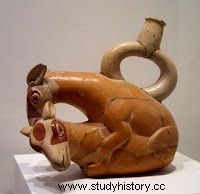
The third type is represented by animals, vegetables and objects, all with anthropomorphic attributes. They are generally involved in ritual warfare, sacrifice, ritual races, etc. A large number of non-domestic animals are part of this group, such as foxes, felines, deer, bats, rodents, lizards, owls, ducks, hummingbirds, hawks, scorpions, centipedes, spiders, etc. Finally, the fourth type includes beings that are anthropomorphic but have fangs in their mouths, wear a snake and fox belt, and other supernatural attributes. These are the most important subjects of the iconography and form a central part of the most elaborate rituals, such as the Presentation Theme, the Mountain Sacrifice ritual and the Burial Theme. Subjects of the third type are usually associated with the activities carried out by individuals with fangs, but generally appear in a subordinate position.
IV. Variants in the Moche sexual act. Within the universe of sexual representations, the male and female genital organs are represented in independent forms in the ceramics; then with the masterly development of sculpture, the representations of phalluses and vulvas are identified in the body context whose representations are always deliberately disproportionate and above all trying to exaggerately stand out in relation to the human body; finally arriving at a varied set of mating relationships in its greatest plastic representation. But the representations are not only referred to men, they also cover the animal and plant world and the gods. That is to say, it deals with a cosmological balance united by a central idea of reproduction or fertility from which man is not a separate being but one more element of the Moche animist and theogonic conception.
The five phases of Moche erotic-sexual art. Larco Hoyle (1945) arranged Moche ceramic art in five phases according to its form at the beginning, flourishing and decadence (warn by the appearance of ceramics that record sexual perversion). His classification: 1.- Representations as a couple. Here sexual activity is completely varied (from kisses, caresses to masturbation and acts against nature), this means freely choosing the will to love. 2.- Representation of intercourse of animals. Representation of greater inventiveness and genius, its aesthetic strength lies in freshness and humor, which does not reach visual fatigue. 3.- Representation of phalluses and vulvas in the human body. They show the man and the woman in their most complete freedom. Sexual potential rises to a magical existence conceived as a symbol of strength and glorification of human survival. 4.- Representation of phalluses and vulvas in containers. Special containers to fill some liquid, with a festive attitude, revelry and humorous court. 5.- Divine representations. These are divine possessions, the sacred descends and possesses the children of man. In an act of great importance with a deep meaning that goes beyond what is seen. (‘’The Mochica’’. Larco H. Rafael. 1945).
This erotic pottery of the Moche culture obeys the character and transparency of their life, style and moral and aesthetic way of the vision of the world that they felt and had, reproduced as is to their ideas and feelings. Among the themes of Moche iconography there is an impressive repertoire of vessels that represent sexual acts, both solo scenes and in various combinations between humans, skeletonized characters and beings with supernatural attributes. Scenes of vaginal intercourse are extremely rare, with the majority being depictions of acts of sodomy, masturbation, and oral sex, as well as depictions of disproportionate male and female genitalia. With one exception, there seems to be a complete dichotomy in sexual activities between strictly non-vaginal and vaginal intercourse. In the first, the individuals involved are generally human, skeletonized characters or others showing facial mutilations. In contrast, in vaginal intercourse, the man generally possesses supernatural attributes such as fangs in his mouth and snake belts with fox heads, a character that has been called "Wrinkled Face" by various researchers. He appears surrounded by anthropomorphized birds and with his companion, an Iguana. Other cases included in this category show animals and sacrificial victims copulating with women. Therefore, the differences between the type of sexual activity and the characters who carry it out must be taken into account to understand the subject. The vast majority of these ritual vessels have been found in funerary contexts. As the funerary ritual is a complex cultural and symbolic activity, it is necessary to first consider whether these scenes could be related to funerary beliefs concerning death itself - as a concept or even as an entity to its liminal aspects or to beliefs in the life of the most there. This is not to say that these vessels were not used in other contexts, such as libation rituals.
Anal intercourse: The most popular scenes are those of anal intercourse. One of the most frequent positions is that of the woman resting on her belly with the man behind her, standing with his legs slightly bent. She frequently holds her partner's shoulders or buttocks firmly. The second position is that of the woman lying on her side and the man in the same position as in the previous case. The third shows both individuals from the side. In the fourth, the couple appears to be seated and the man behind her. The fifth shows the woman from behind with the man standing on her, and in the last, the man is lying on his back with the woman sitting on him. When the genitals are visible, as usual, the artists made it clear with minute detail that the sexual act consists of anal intercourse. In fact, no anatomical detail is left to the imagination in order to depict the exact nature of the sexual act, and the female genitalia, including the labia and clitoris, are often clearly delineated. Although this gesture is not systematically performed, the male he frequently holds his partner's chin, which also occurs in scenes involving an eventual sacrificial victim. Therefore, this representation must have a more complex symbolic meaning that will be explored in detail later.
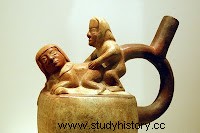
Vessels showing anal intercourse are usually decorated with a series of horizontal bands of cream and ochre, also frequent on the sides of representations of stepped platforms. As proposed by Elizabeth Benson (1972:138), this design could well symbolize the form of a Moche temple. Therefore, if the meaning of the bands is to represent a monumental structure, their association with sexual scenes would emphasize the highly symbolic nature of the sexual act. In the following case the relationship with the symbol is expressed even more clearly as a double staircase motif has been painted just below the couple. This motif could represent the double staircase usually present in ceramics of architectural forms. Several of the elements that accompany the sexual representations, such as drawings of vessels, tied rectangular copper objects or the carpet on which the woman often appears lying, have commonly been found in reality as part of the Moche funerary paraphernalia. representations of anal intercourse commonly include a child lying next to the partner or being suckled during intercourse. Some experts see in these representations a kind of birth control in order to guarantee the newborn enough milk to survive (Dobkin de Ríos 1984; Gebhard 1970; Kauffmann Doig 1978). However, the theme of sexual representation and two scenes of anal intercourse shown below contradict this interpretation. Furthermore, in some cases the man has been replaced by characters that are closely related to funerary and sacrificial symbols, such as an individual with an excised nose and lips, a skeletonized character or a one-eyed man who has lost his earmuffs, which would identify as a captive and possible sacrificial victim. Consequently, in the scene of anal copulation, transitory beings such as those mentioned are directly involved. The close relationship of women with skeletal beings and with these especially marked beings seems to reinforce the role of women or the female gender in relation to death, sacrifice and funerary rituals.
Masturbation Male masturbation ranks second in the range of numerical importance of this peculiar iconographic body. As Larco (1965) noted, women's faces often reflect an expression of indifference or anger. Sometimes, like in the oral sex scenes, the woman has a disgusted expression and appears to be trying to back away from the sexual act. It is possible that these facial expressions want to express the non-existence of sexual pleasure and emphasize the ritual dimension. As we will see later, it is even more apparent that the woman is forced to perform acts of oral sex. The main difference between the masturbation scenes and the anal intercourse scenes is not only the greater representation of skeletal men in the former, but the number of skeletonized women. In general, scenes of this type seem to bring together the main elements that are part of a funerary ritual:the female gender, funerary offerings, music and sexual activity. In the Theme of Masturbation, the symbolic duality seems to have been expressed in at least two different ways. The couple is often painted in two contrasting colors, with the woman always illustrated in red and her skeletal companion in white. In most scenes involving a woman and a skeletal male, the woman is positioned to the left of her partner. This could validate the idea that left and right may have been part of the dualistic principle of Moche symbolism, which is beautifully expressed in the tombs of Sipán, with the gold objects placed to the right of the main individual and the silver ones placed, on his majority, to their left (Alva and Donnan 1993:223).
Oral sex: As I pointed out previously, it seems that most oral sex scenes represent the man forcing the woman to perform the act (Figure 30), which present two variations. In the first, both characters face each other side by side, with the man holding or pushing his female partner's head toward his erect penis. The second position shows the man sitting on a kind of rectangular seat with his partner sitting on the floor right in front of him. The man sitting on a platform or throne, and the scale design painted on the two bottles, would give force to the ritual nature of the sexual act. The standing position of the man during oral sex is quite unusual. Although the gestural language of Moche iconography has not been studied so far, it allows us to reiterate once again the close relationship that may have existed between the sexual scenes and the broad concept of ritual warfare and human sacrifice. Similarly, as we will see later, the connection between certain sexual activities and the funerary context is not only marked by the presence of skeletal figures in numerous scenes, but also by showing anal intercourse taking place next to a burial.
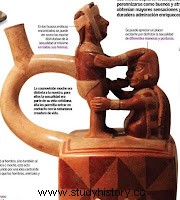
Libation penises: What we call Libation Penises represent the third reason in order of quantitative importance. They commonly correspond to the representation of a male individual endowed with a huge penis. He can be a man standing, sitting on a throne, or a skeletal being. The liquid has to be introduced through the subject's head; however, in some cases, if one tried to drink or pour the liquid over the head, it would escape through the holes around the edge of the vessel. Therefore, it is mandatory to pour or drink through the hole in the penis. These cases connect the idea of seminal fluid and the ritual of oral sex. The scenes of oral sex and male libation vessels must have been cognitively related. The erection of a “live” penis exhibited by the skeletonized character in Figure 34 can also be seen in numerous skeletons in the iconography; as if to indicate that they maintain a certain vitality after his death. Certain physiological reasons, such as post-mortem erections, could explain these beliefs and the presence of erect penises in skeletal beings. Given the importance that the Moche attached to funerary rituals and sacrificial practices, there is little doubt that they had the opportunity to observe such erections. For a society apparently so interested in the continuation of life after death, an indisputable sign like a post-mortem erection must have been seen as definitive proof that life continued after Death. Therefore, these post-mortem erections would represent a tangible demonstration of fertility provided, perhaps, by beings with supernatural attributes that would exist even after death.
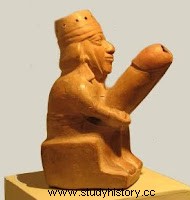
Libation vaginas The female gender is also represented on libation vessels, commonly with enormous genitalia. It is very possible that these vessels were used to contain certain liquids. In some cases, the vagina leads to a double cavity within the chamber of the vessel. If one pours liquid through the vagina into the vessel, it completely disappears inside the woman's body. Consequently, if it is a question of drinking or serving liquid in this type of vessel, the liquid will reappear from the woman's body through the vagina. The relationship between these libation vessels and earlier ones showing exaggeratedly large male genitalia is further reinforced by the fact that the woman inside the bowl in Figure 36 is performing the fisted hand gesture with both hands. Therefore, it seems plausible that the meaning of these vessels is associated with oral sex activity. In this case, the pieces would be specifically related to the concept of fertility associated with the female gender.
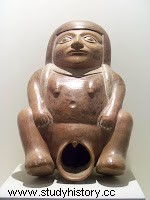
Anthropomorphic male genitalia The anthropomorphized male genitalia emphasize the symbolic relationship that seems to exist between the head and the penis. In some cases, the head of the penis literally takes the form of a human head. In the first example, the testicles are modeled directly on the body of the vessel and what appears to be a vagina with pubic hair has been painted around the penis. In both cases these head penises, which have earmuffs, have a hand on their nose. The key to understanding this gesture can be found in the representation of the war ritual, since in numerous scenes the captured warriors are illustrated bleeding from their noses and the victims systematically put their hands to their noses. This bleeding would have been part of the ritual sequence (Donan 2003:114). As all representations of penises in iconography show evidence of circumcision, it is not unreasonable to suggest that the shedding of blood in a circumcision ritual must have been seen as sacrifice. This hypothesis is reinforced by these anthropomorphized penises with tubular earspools like those of warriors. These ornaments are specific to a particular group of male individuals and their removal on a defeated warrior is an additional sign of capture and eventual sacrifice. In other cases the penis is completely anthropomorphized.
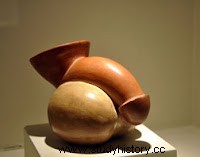
Homoerotic activities in Moche pottery. With the arrival of the Europeans, historical evidence of homosexual activities appeared in the literature of the 16th century. So far no one has written specifically on the topic of homosexuality in Peruvian art. In Peru, although there is a large amount of erotic art to study, only a few professors have made statements about the nature of homosexual activities in erotic art. Rafael Larco Hoyle (1965:110) who denies the presence of homosexual activities (and bestiality) in all the ancient art of Peru, admits that a representation possibly exists. In addition, he states that these exist as moralizing attempts, serving as an "extreme warning" to what will happen to people who are too sexual. Oscar Urteaga Ballén (1968:327) reaches a similar conclusion. He says that homosexual activities do exist but that they are rare and represent "abnormal" and "perverse" behavior. Federico Kauffmann Doig (1978:54-56) he says that the figures represent homosexual activities but that these are rare in the erotic tradition of ancient Peru. Homosexual activities, depicted in Moche art, seem to reflect sexual behavior connected to religious rites in which various classes or social groups (including priests) participated. (...). It should be noted that homosexual activities in Peru continued to be practiced for religious purposes for some 800 years after the fall of the Moche culture. The representation of these figures in rituals suggests that they were integrated into a religion with sexual orientations. But it should be noted that in Moche art the high frequency of anal intercourse and masturbation indicates that Moche eroticism was not dedicated to the religion of fertility. (Artistic representations of homoerotic activities in the Moche culture’’. Arboleda C. Manuel. 1981:105)
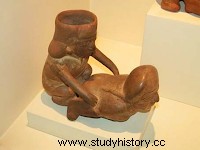
Part IV:Prostitution among ancient Peruvians. An issue, discussed and debated in various chronicles, including the ‘’Comentarios Reales’’ by Garcilaso de la Vega and several "anonymous" is that of sexual prostitution among ancient Peruvians. He has referred to the presence of women who exercised this activity and who were called "pampayruna" which would mean public woman, harlot or prostitute. The way in which their presence is described is varied and seems to correspond to the moral attitude, especially religious, that each chronicler assumed when narrating the event. An anonymous Jesuit chronicler describes it as follows:"The Inca allowed women of licentious life, single women who were not virgins or widows, or the mistresses, or the legitimate wives of each one, to come to houses or hideouts, so that they committed crimes there. heinous adulteries or rapes. 'Juan B. Lastres in his ''History of Peruvian Medicine'', Vol. I, The Inca medicine, refers to the description made by Garcilaso de la Vega on an issue and presents it in these terms:''the same chronicler It tells us about women of unholy life, which the Incas allowed, to avoid further damage to the population. They lived in the fields, in isolated huts, they couldn't enter the villages because they didn't communicate with the other women. (...) the men treated them with great contempt (...) these measures of the Incas speak well of a legislation of prostitution''''. (Sexuality in pre-Columbian Peru''. Cáceres V. Artidoro. P. 49).
The Servinacuy or trial marriage. Very often today's Peruvians are heard saying that there was or is in these times a ritual of coexistence that has been agreed to qualify with a mestizo term:"Servinacuy" or "Sirvinacuy" which would mean "period of mutual service" and that is preliminary to the consolidation of the union between a man and a woman, giving the word "consolidate" the meaning of "ensure completely" or "affirm more and more" The alliance. The modality, custom, ritual or whatever you want to call it, was practiced and is practiced with seriousness, responsibility, respect and dignity. It is a stage of mutual knowledge, assessment of qualities and observation and correction of defects "before it is too late" and the observation and qualification extends to the family group, especially women, who remain attentive to the evolution during the ''test'' time. This word has ended up sealing the qualifier ''trial marriage''. It is neither ''marriage'' nor is it ''test''. It is not marriage in the sense of a sacrament, nor is it in that of a “legal” union. Yes, it is in the sense of "union of man and woman arranged through certain rites". It is not "proof" in the sense of approving something for someone else to use; neither is it in the superficial, irresponsible and immature understanding of ''if it doesn't work out for me, then I'm out''. It's not even proof in concept of "I'm going to get experience for the future." It is, in the sense of reason, argument, action with which a quality of feelings, ideas, plans, experiences, intentions is shown or made clear, assembling them or trying to assemble them with those of the couple. The unfortunate thing about the term ''test'' is in the ''experimental'' content of ''rehearsal'', of ''elementary learning'' given by many people who interpret this true initiation ritual, an interpretation tinged with Western prejudice, Catholic and legalistic. (Sexuality in pre-Columbian Peru''. Cáceres V. Artidoro. P. 113).
The chroniclers, as mentioned pages ago, do not clearly refer to these customs. The first thing that comes to mind is the idea that Cieza de León took very literally and judged the facts that he saw based on his principles and customs. In chapter XLIX of his "Chronicles of Peru" he mentions the following:"...before they married those who were to have a husband, they corrupted them using their lusts with them." We now know that in Spain no woman could live with a man before marriage, but in ancient Peruvian cultures it was possible and even necessary, not because of "corrupting" or "sexually initiating" them, but because of the to preserve the family. It is unknown to anyone that in the Ancient Peruvian Cultures and in the current highlands of our current Peru, the Servinacuy existed and exists. En base a este alto valor institucionalizado, se puede asegurar que el hombre peruano pre-inca e inca, fue un gran y excelente planificador familiar y en consecuencia un sobresaliente planificador social.
CONCLUSIONES En base a lo expuesto y a los ya mencionados interrogantes sobre la sexualidad en el Perú y ¿Qué enseñanza se puede sacar de ella? o ¿Puede esta enseñanza servir al hombre de hoy o al de mañana? Mi franca opinión es que si puede y de hecho sirve al hombre de hoy para inspirarse en el hombre de ayer. Y mejor aun, pienso que esta actitud puede representar un estímulo mayor y una mejor proyección hacia los años que vendrán. Sin reparar en prejuicios y vanos intentos de aplicar dogmatismos en sociedades totalmente diferentes a la actual. Comprendiendo que la sexualidad no solo se limita al morbo, sino que puede y debe tener fines educativos, espirituales y preservantes en la continuidad de la especie.
BIBLIOGRAFÌA
- ARBOLEDA, Manuel. ‘’Representaciones Artísticas de Actividades Homo eróticas en la cerámica Moche’’En:Revista Boletín de Lima, Nº especial, 16-17-18, Pág. 98-107.1981Lima, Perú.
- BORJA Jiménez, A. ‘’Moche:arte y tesoros del Perú’’Banco de crédito del Perú en la cultura. 1985. Lima, Perú.
- BENSON, E. ‘’The Mochica:A Culture of Peru’’. 1972 Praeger, London.
- CACERES Velásquez, Artidoro. ‘’La sexualidad en el Perú pre-colombino’’. Edit.Consejo Nacional de Ciencia y Tecnología CONCYTEC. Lima, Perú.
- CIEZA DE LEÒN, Pedro. ‘’Crónicas del Perú’’. PUCP . 1986. Lima, Perú.
- KAUFFMANN Doig, F. ‘’El Perú arqueológico:tratado breve sobre el Perú pre-incaico’’. KOMPAKTOS G.S. Surquillo. 1970. Lima, Perú
- LARCO Hoyle, Rafael. ‘’Los Mochica’’. Sociedad Geográfica Americana. 1945 . Buenos Aires, Argentina.
- LARCO Hoyle, Rafael. ‘’Checan’’ ensayos sobre las representaciones eróticas del Perú pre-colombino. 1966. Nagel, Ginebra.
- MIRANDA Cueto, Hernán. ‘’Manifestaciones sexuales en la cerámica pre-hispánica’’.,En:Revista del Museo de Arqueología Nº especial, 4, Pág. 141-147. 1993. Trujillo, Perú.
- PORRAS Barrenechea, Raúl. ‘’Las crónicas del Perú:1528-1650’’. Gracie &Cía. 1962. Lima, Perú.
- URTEAGA Ballón, Oscar. ‘’Interpretación de la cerámica en el antiguo Perú’’. Museo de Paleo-Patología – Hospital 2 de Mayo. 1968. Lima, Perú.
- VERGARA Montero, Enrique. ‘’Concepción de sexualidad en el antiguo Perú’’. En:Revista del Museo de Arqueología Nº especial, 4, Pág. 149. 1993 . Trujillo, Perú.
- ZEVALLOS Quiñones, J. ‘’Área y fases de la cultura Moche’’. En:Culturas pre-colombinas:Moche. Banco De Crédito del Perú – Valverde S.A. Pág. 102. 1985 Lima, Perú.
